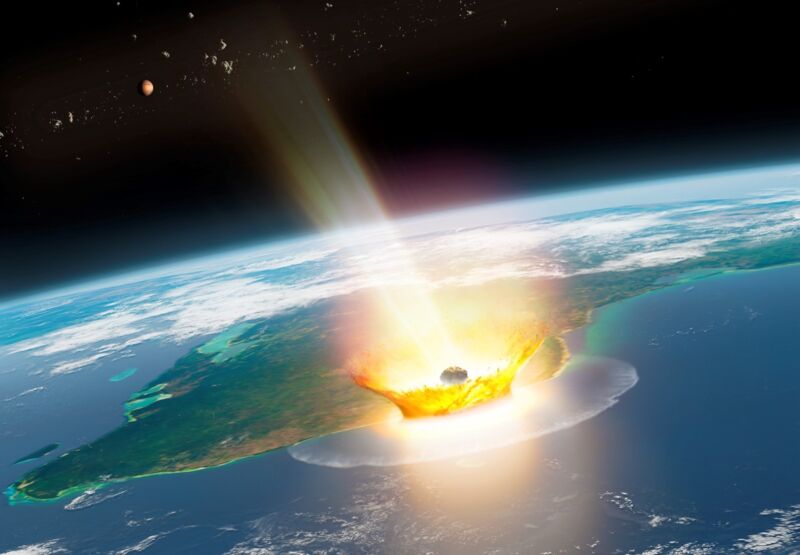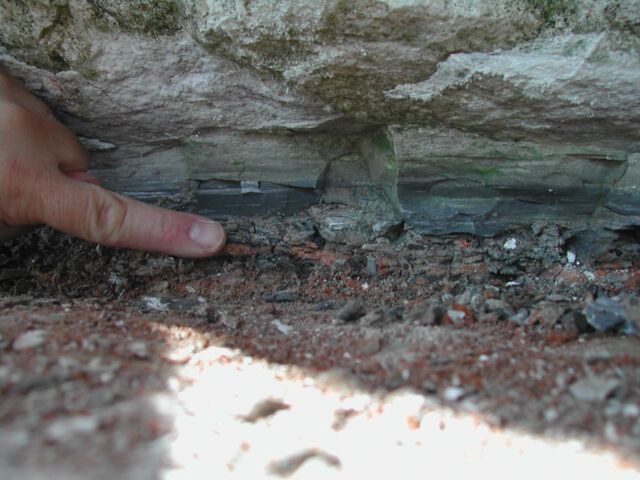
Mark Garlick
Some 66 million years ago, an errant asteroid wiped out three-quarters of all plant and animal species on Earth, most notably taking down the dinosaurs. That has long been the scientific consensus. However, three years ago, Harvard astronomers offered an alternative hypothesis: The culprit may have been a fragment of a comet thrown off-course by Jupiter’s gravity and ripped apart by the Sun.
Now an international team of scientists have reaffirmed the original hypothesis, according to a new paper published in the journal Science. They analyzed ruthenium isotopes from the Chicxulub impact crater and concluded the impact was due to a carbonaceous-type asteroid, likely hailing from beyond Jupiter.
As previously reported, the most widely accepted explanation for what triggered that catastrophic mass extinction is known as the “Alvarez hypothesis,” after the late physicist Luis Alvarez and his geologist son, Walter. In 1980, they proposed that the extinction event may have been caused by a massive asteroid or comet hitting the Earth. They based this conclusion on their analysis of sedimentary layers at the Cretaceous-Paleogene boundary (the K-Pg boundary, formerly known as the K-T boundary) found all over the world, which included unusually high concentrations of iridium—a metal more commonly found in asteroids than on Earth. (That same year, Dutch geophysicist Jan Smit independently arrived at a similar conclusion.)

Philippe Claeys
Since then, scientists have identified a likely impact site: a large crater in Chicxulub, Mexico, in the Yucatan Peninsula, first discovered by geophysicists in the late 1970s. The impactor that created it was sufficiently large (between 11 and 81 kilometers, or 7 to 50 miles) to melt, shock, and eject granite from deep inside the Earth, probably causing a megatsunami and ejecting vaporized rock and sulfates into the atmosphere.
This in turn had a devastating effect on the global climate, leading to mass extinction. In 2022, scientists suggested that one reason so many species perished while others survived may have been because the impact occurred in the spring (at least in the Northern Hemisphere), thereby interrupting the annual reproductive cycles of many species.
In 2016, a scientific drilling project led by the International Ocean Discovery Program took core samples from the crater’s peak ring, confirming that the rock had been subjected to immense pressure over a period of minutes. A 2020 paper concluded that the impactor struck at the worst possible angle and caused maximum damage. It has been estimated that the impact would have released energy over a billion times higher than the atomic bombs dropped on Hiroshima and Nagasaki in 1945.
Asteroid or comet?
Harvard’s Avi Loeb and his then-undergraduate student Amir Siraj challenged the asteroid-as-impactor hypothesis in a 2021 paper, proposing instead that the impact was caused by a special kind of comet—originating from a field of debris at the edge of our solar system known as the Oort cloud—that was thrown off course by Jupiter’s gravity toward the Sun. The Sun’s powerful tidal forces then ripped off pieces off the comet—akin to what happened to the comet Shoemaker-Levy 9 when it crashed into Jupiter in 1994—and one of the larger fragments of this “cometary shrapnel” eventually collided with Earth.
Loeb and Siraj’s analysis was based on numerical simulations to calculate the flux of long-period comets in our solar system. They found that events like the one described above should happen frequently enough and produce enough sufficiently large fragments to result in a significantly higher impact rate of Chicxulub-sized impactors than the background comet or asteroid populations. They argued that their comet hypothesis would also explain the Chicxulub impactor’s unusual composition of carbonaceous chondrite—rare for asteroids but more common for long-period comets—which is consistent with an Oort cloud origin rather than the main asteroid belt.
This latest paper addresses that latter point in particular. Mario Fischer-Gödde of the University of Cologne in Germany and his co-authors took samples from the K-Pg boundary layer from a site at Stevns Klint in Denmark and analyzed the ruthenium isotopes via plasma mass spectrometry. They did the same for samples taken from the sites of five other known asteroid impacts over the last 541 million years, as well as ancient Archean samples (between 3.5 to 3.2 billion years old).
Fischer-Gödde et al. concluded that the ruthenium signatures in the K-Pg samples were a close match to asteroids known as carbonaceous chondrites, so the impact most likely resulted from a C-type asteroid that hailed from the outer Solar System. They were able to rule out the possibility of a comet impactor proposed by Loeb and Siraj since the ruthenium data was inconsistent with that hypothesis. Most of the other samples had ruthenium isotope signatures consistent with salicaceous (S-type) asteroids from the inner Solar System, although the ancient Archean samples were also consist with a C-type asteroid.
Science, 2024. DOI: 10.1126/science.adk4868 (About DOIs).
